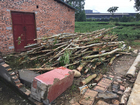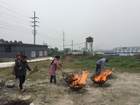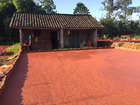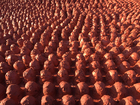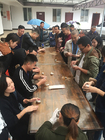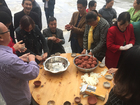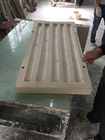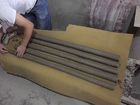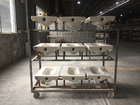Cosmopolis #1.5: Enlarged Intelligence
Mao Jihong Arts Foundation in collaboration with the Centre Pompidou
Chengdu, Sichuan Province, China
curated by Kathryn Weir
November 2, 2018–January 6, 2019
Yasmin Smith – Flooded Rose Red Basin, 2018
During October/November 2018, Yasmin Smith undertook a seven-week residency in Sichuan province in southwest China to produce a major new ceramics installation, Flooded Rose Red Basin, for Cosmopolis #1.5: Enlarged Intelligence, curated by Kathryn Weir (with associate curator Ilaria Conti and assistant curator Zhang Hanlu). It is the second major exhibition associated with the biennial Cosmopolis platform which was launched by the Centre Pompidou, Paris, in 2016. Cosmopolis #1.5 is supported by the Mao Jihong Arts Foundation and hosted in Chengdu.
Smith’s studio for Cosmopolis #1.5 was the Jinhui Ceramic Sanitary Ware Factory in Wuchangzhen in the agricultural and industrial lands of the Chengdu Plain. This site is geologically situated in the Sichuan Red Basin. There she developed and produced a major new site-specific installation, Flooded Rose Red Basin, which included three new ash glazes derived from organic material sourced in the area.
Smith’s initial research directed her investigation into local bamboo as a material for the creation of a bamboo ash glaze. The main chemical element found in bamboo ash is silica. Silica is essential to life. It is ubiquitous, used in a multitude of industrial processes and technologies that sustain human populations. Silica is the second most abundant element in the earth’s crust and in relation to the ceramic process it is indispensable.
These qualities as well and current research into bamboo ash as a possible source of biosilica for use in future technologies drew Smith to the investigation. During her time in Sichuan and observing the surrounding landscape, she noticed large plantations of Flooded Gum, known also as Rose Gum (Eucalyptus grandis), a species of eucalyptus tree native to Australia. These eucalypts are planted along road sides and around farming land, bordering fields of green tea.
Eucalyptus plantations in China were implemented as a measure to rehabilitate forest and stabilise soil erosion while also providing a revenue stream. The Flooded Gums were planted because of their fast-growing qualities aiding rapid economic turnover. However, they are also voracious water consumers, taking water and nutrients from neighbouring green tea plantations and, as an introduced monoculture, have had adverse effects on the local ecosystem.
In response to the presence of these trees, Smith has produced three separate site-specific ash glazes derived from Flooded Gum wood, green tea wood and bamboo to compare the glaze evidence gleaned from these plants, the heavy metal and chemical compositions of the plants' ashes, as well as the morphology and physiology of these species grown in the same environment.
Smith’s glazes were applied to corresponding ceramic casts of the plant specimens made from the factory's industrial clay, as well as to small, handmade objects produced from local Meishan Tudi (a bright red, iron oxide rich) clay by workers at the Jinhui Ceramic Sanitary Ware Factory during participatory workshops. Smith employed the labour of the factory workers for mould-making and casting/modeling of all the objects for Flooded Rose Red Basin and the kilns in the factory for firing them. The steel frame on which the pinch cups are exhibited is based on the production frames from the fabrication of ceramic toilets in the factory.
Plants have biological mechanisms that allow the absorption of minerals, nutrients and toxins from soil and water through osmosis. The non-soluble inorganic elements remain in the ash after the plant material is burnt. Flooded Rose Red Basin makes visible these elements and, through aesthetic evidence of its three glazes, points to a narrative of the place that may have been influenced by anthropogenic activities and the natural geochemistry of the site, presenting, via aesthetic outcomes, a deeper understanding of these interconnected relationships.
















